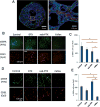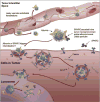Modifying the tumor microenvironment using nanoparticle therapeutics
- PMID: 27038329
- PMCID: PMC5045752
- DOI: 10.1002/wnan.1406
Modifying the tumor microenvironment using nanoparticle therapeutics
Abstract
Treatment of cancer has come a long way from the initial 'radical surgeries' to the multimodality treatments. For the major part of the last century, cancer was considered as a monocellular disorder, and treatment strategies were designed according to that hypothesis. However, the mortality rate from cancer continued to be high and a comprehensive treatment remained elusive. Recent progress in research has demonstrated that tumors are a complex network of neoplastic and non-neoplastic cells. The non-neoplastic cells, which are collectively called stroma, assist in tumor survival and progression. It has been shown that disrupting the tumor-stromal balance leads to significant effects on the tumor survival, and effective treatment can be achieved by targeting one or more of the stromal components. In this review, we summarize the roles of various stromal components in promoting tumor progression, and discuss innovative nanoparticle-mediated drug targeting strategies for stromal depletion and the subsequent effects on the tumors. Perspectives and the future directions are also provided. WIREs Nanomed Nanobiotechnol 2016, 8:891-908. doi: 10.1002/wnan.1406 For further resources related to this article, please visit the WIREs website.
© 2016 Wiley Periodicals, Inc.
Figures







References
-
- Fidler IJ. The pathogenesis of cancer metastasis: the ‘seed and soil’ hypothesis revisited. Nat Rev Cancer. 2003;3:453–458. - PubMed
-
- Teicher BA, Herman TS, Holden SA, Wang YY, Pfeffer MR, Crawford JW, Frei E., 3rd Tumor resistance to alkylating agents conferred by mechanisms operative only in vivo. Science. 1990;247:1457–1461. - PubMed
Publication types
MeSH terms
Substances
Grants and funding
LinkOut - more resources
Full Text Sources
Other Literature Sources

